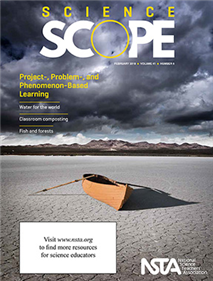All Resources
Journal Article
Jumping Into Natural Selection
Thought experiments and firsthand investigations with crickets help students construct explanations of natural selection....
Journal Article
An Introduction to Heredity: Part 1
Third-grade students learn about traits and how their combinations makes us unique....
Journal Article
An Introduction to Heredity: Part 2
Students explore concepts related to heredity....
Journal Article
A Dazzling Journey to an Aquarium Ecosystem
Using instructional technology engages students with close-up views of organisms....
Journal Article
Editor's Note: Observing Heredity
Science and Children’s editor shares thoughts regarding the current issue....
Journal Article
The Early Years: Teaching Life Cycles Throughout the Year
This column discusses resources and science topics related to students in grades preK to 2. This month’s article shows how to introduce children to animals and their offspring commonly seen in children’s literature....
Journal Article
Formative Assessment Probes: Uncovering Students’ Ideas About Inherited Traits
This column focuses on promoting learning through assessment. This month’s issue discusses the “Baby Mice” probe, which is designed for middle and high school students, but it can be used with grades 3–5 to elicit students’ initial ideas ab...
Journal Article
Teaching Through Trade Books: Investigating Heredity
This column includes activities inspired by children’s literature. Younger students must be able to recognize that animals or plants of the same species can be similar, but there is still variation within a species. This idea is examined in this mo...
Journal Article
The Poetry of Science: Comparing Cats
Building literacy in playful, meaningful ways. This issue investigates characteristics and traits of the lion and the house cat....
Journal Article
This column provides background science information for elementary teachers. This issue answers the question while discussing genetics and evolution....
Journal Article
This column shares exercises to challenge content knowledge. This issue presents a new challenge and answers the A Bunny of a Different Color challenge from last month....
Journal Article
Engineering Encounters: Goldilocks and the Engineers
This column presents ideas and techniques to enhance your science teaching. This issue shares information about developing science discourse and understanding with kindergarten students....
Journal Article
Methods and Strategies: Drawing for Meaning
Students develop three-dimensional skills through scientific drawings....
Journal Article
Outstanding Science Trade Books for Students K–12: 2018
Recently published books selected by the Children’s Book Council and the National Science Teachers Association....
Journal Article
Composting: A Problem, Place, or Project? Using the PBL Trifecta (PBL3) in the Classroom
Combine problem-, place-, and phenomenon-based learning to engage students in a composting project....
Journal Article
Add phenomena to your teaching to support three-dimensional instruction....
Journal Article
A Framework for Integrating Science, Engineering, and Literacy
Incorporate scientific texts into lessons to help students make crosscurricular connections....




